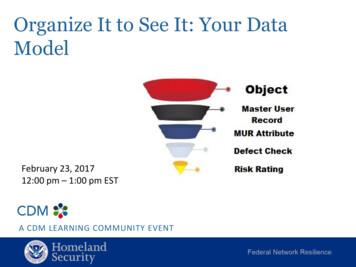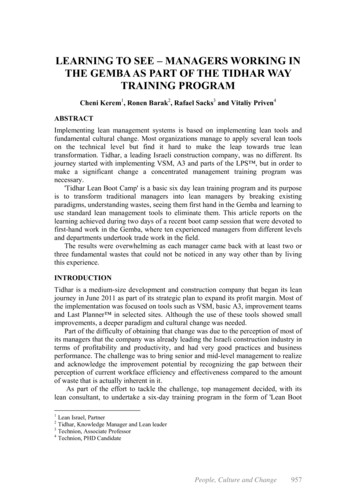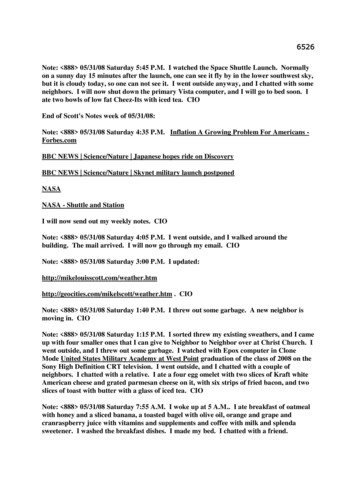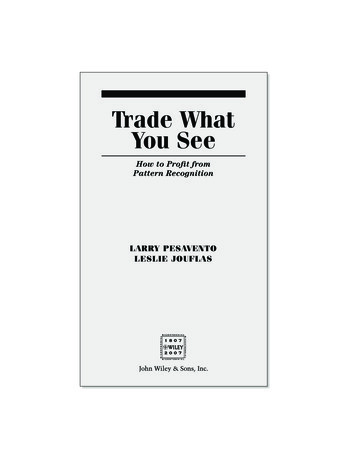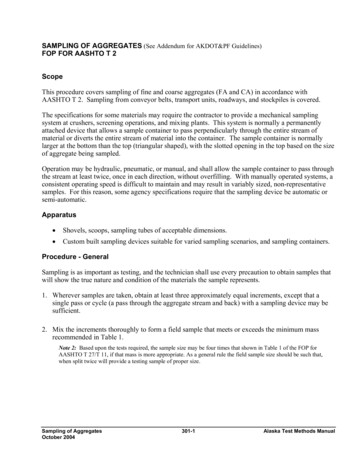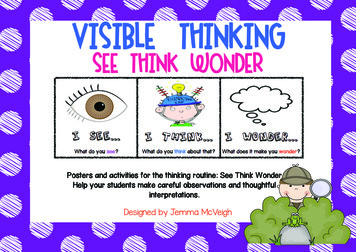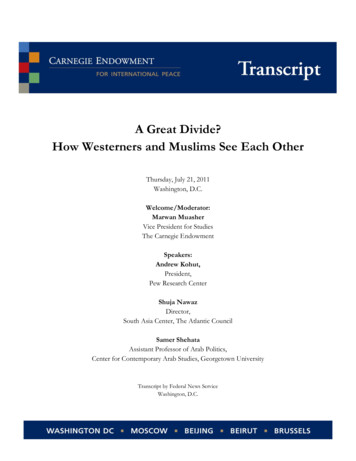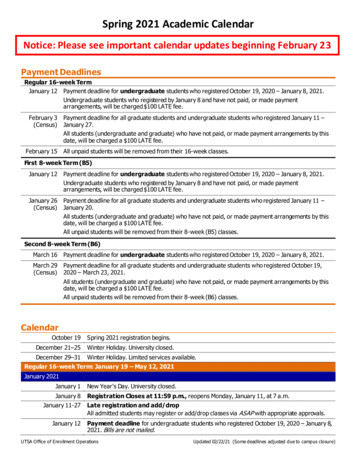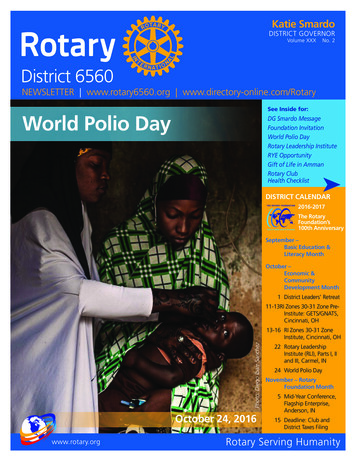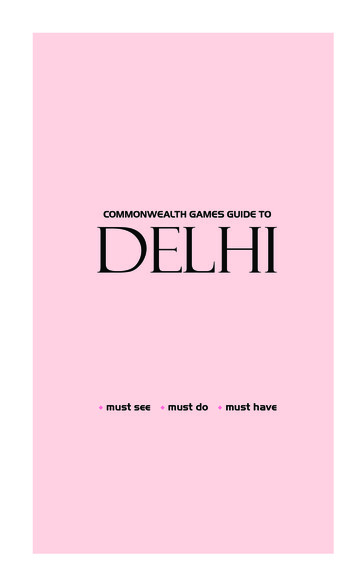
Transcription
01-History-delhi-without-AD.qxd8/25/201011:45 AMCOMMONWEALTH GAMES GUIDE TODELHI must see must do must havePage 1
01-History-delhi-without-AD.qxd8/25/201011:45 AMPage 2Editorial: Chetananand SinghResearcher: Poulomi SarmaDesign team: Subhasish Munshi, Balkishan VermaProduction: Neeraj BhartiProject editor: Madhulita MohantyCommonwealth Games Guide to DELHICopyright Bennett, Coleman & Co. Ltd., 2010Published in 2010This customized book has been produced byBennett, Coleman & Co. Ltd.7, Bahadur Shah Zafar MargNew Delhi-110 002For Delhi Tourism & Transportation Development Corporation Ltd.All rights reserved.No part of this work may be reproduced or used in any form or by any means (graphic,electronic, mechanical, photocopying, recording, tape, web distribution, information storageand retrieval systems or otherwise) without prior written permission of the publisher.Disclaimer:The content as provided in this Book does not represent the views of the Publisher. Publishershall be free from any liability for damages and losses of any nature arising from or related tothe content of the Book. Due care and diligence has been taken while printing and editing theBook. The Publisher does not hold any responsibility for any mistake that may have crept ininadvertently.Conceived and Developed byTimes Group BooksTimes Annexe, 9-10, Bahadur Shah Zafar Marg, New Delhi-110002Printed at: Ajanta Offset & Packagings Ltd.Not for Sale
01-History-delhi-without-AD.qxd8/25/201011:45 AMPage 3DELHI FACTS . . . . . . . . . . . . . . . . . . . . . . . . . . . . . . . . . . . . . . . . . . . . . . .4INTRODUCTION . . . . . . . . . . . . . . . . . . . . . . . . . . . . . . . . . . . . . . . . . . . .5HISTORY AT A GLANCE . . . . . . . . . . . . . . . . . . . . . . . . . . . . . . . . . . . . .6TALE OF A ROYAL CITY . . . . . . . . . . . . . . . . . . . . . . . . . . . . . . . . . . . . .8ITINERARIES . . . . . . . . . . . . . . . . . . . . . . . . . . . . . . . . . . . . . . . . . . . . . . .13OLD DELHI . . . . . . . . . . . . . . . . . . . . . . . . . . . . . . . . . . . . . . . . . . . . . . . .27TAKE A WALK . . . . . . . . . . . . . . . . . . . . . . . . . . . . . . . . . . . . . . . . . .34TAKE A BREAK . . . . . . . . . . . . . . . . . . . . . . . . . . . . . . . . . . . . . . . . .40Eating . . . . . . . . . . . . . . . . . . . . . . . . . . . . . . . . . . . . . . . . . . . . . . . .40Shopping . . . . . . . . . . . . . . . . . . . . . . . . . . . . . . . . . . . . . . . . . . . . .45AROUND OLD DELHI . . . . . . . . . . . . . . . . . . . . . . . . . . . . . . . . . . . . . .49TO THE EAST OF OLD DELHI . . . . . . . . . . . . . . . . . . . . . . . . . .50TO THE NORTH OF OLD DELHI . . . . . . . . . . . . . . . . . . . . . . .55TAKE A BREAK . . . . . . . . . . . . . . . . . . . . . . . . . . . . . . . . . . . . . . . . .62Eating . . . . . . . . . . . . . . . . . . . . . . . . . . . . . . . . . . . . . . . . . . . . . . . .62Shopping . . . . . . . . . . . . . . . . . . . . . . . . . . . . . . . . . . . . . . . . . . . . .63CENTRAL DELHI . . . . . . . . . . . . . . . . . . . . . . . . . . . . . . . . . . . . . . . . . . .65TAKE A BREAK . . . . . . . . . . . . . . . . . . . . . . . . . . . . . . . . . . . . . . . . .89Eating . . . . . . . . . . . . . . . . . . . . . . . . . . . . . . . . . . . . . . . . . . . . . . . .89Nightlife . . . . . . . . . . . . . . . . . . . . . . . . . . . . . . . . . . . . . . . . . . . . .97Shopping . . . . . . . . . . . . . . . . . . . . . . . . . . . . . . . . . . . . . . . . . . . . .99SOUTH DELHI . . . . . . . . . . . . . . . . . . . . . . . . . . . . . . . . . . . . . . . . . . . .105TAKE A BREAK . . . . . . . . . . . . . . . . . . . . . . . . . . . . . . . . . . . . . . . .141Eating . . . . . . . . . . . . . . . . . . . . . . . . . . . . . . . . . . . . . . . . . . . . . . .141Nightlife . . . . . . . . . . . . . . . . . . . . . . . . . . . . . . . . . . . . . . . . . . . .154Shopping . . . . . . . . . . . . . . . . . . . . . . . . . . . . . . . . . . . . . . . . . . .160OTHER ATTRACTIONS . . . . . . . . . . . . . . . . . . . . . . . . . . . . . . . . . . .169TAKE A BREAK . . . . . . . . . . . . . . . . . . . . . . . . . . . . . . . . . . . . . . . . . . . .177Eating . . . . . . . . . . . . . . . . . . . . . . . . . . . . . . . . . . . . . . . . . . . . . . .177Nightlife . . . . . . . . . . . . . . . . . . . . . . . . . . . . . . . . . . . . . . . . . . . .183Shopping . . . . . . . . . . . . . . . . . . . . . . . . . . . . . . . . . . . . . . . . . . .186RECIPES . . . . . . . . . . . . . . . . . . . . . . . . . . . . . . . . . . . . . . . . . . . . . . . . . .189EXCURSIONS . . . . . . . . . . . . . . . . . . . . . . . . . . . . . . . . . . . . . . . . . . . . .197LISTINGS . . . . . . . . . . . . . . . . . . . . . . . . . . . . . . . . . . . . . . . . . . . . . . . . .213INDEX . . . . . . . . . . . . . . . . . . . . . . . . . . . . . . . . . . . . . . . . . . . . . . . . . . . .253CONTENTSCONTENTS
01-History-delhi-without-AD.qxd8/25/201011:45 AMDelhi FactsArea: 1,483 sq kmLatitudinal parallel: 28.3ºNLongitudinal meridian: 77.13ºEAltitude: 293 m above sea levelPopulation: 12.8 millionAverage Temperature: 45ºC (Max) — usually inMay–Jun, 5ºC (Min) — usually in Dec–JanDesirable Clothes: Woollen for winters andlight cotton for summersRainfall: 1,272 mmMonsoon: July to mid-SeptemberSeason: Extreme climate with very hot summerand very cold winterBest time to visit: October to MarchSTD Code: 011Languages: Hindi, English, Urdu and PunjabiReligions: Hinduism, Islam, Sikhism, Buddhism,Jainism, Christianity, Zoroastrianism, Judaismand Baha’i FaithPage 4
01-History-delhi-without-AD.qxd8/25/201011:45 AMPage 5Delhi is a city of many layers. It bridges two differentworlds. Old Delhi, once the capital of Islamic India, is alabyrinth of narrow lanes lined with crumbling havelisand formidable mosques. In contrast, the imperial city of NewDelhi created by the British Raj is composed of spacious, tree-linedavenues and imposing government buildings.Delhi has been the seat of power for several rulers and manyempires for about a millennium. Many a city was built, destroyedand then rebuilt here. Interestingly, many of Delhi’s rulers played adual role, first as destroyers and then as creators.The city’s importance lies not just in its past glory as the seat ofempires and magnificent monuments, but also in the rich anddiverse cultures. No wonder chroniclers of Delhi culture — fromChand Bardai and Amir Khusro to William Dalrymple andfilm-maker Dibakar Banerjee — are never at a loss for topics.For first-timers, Delhi can seem chaotic and confusing with itscrazy traffic. But scratch the surface and you will discover that thecity is sprinkled with dazzling gems: captivating ancientmonuments, fascinating museums and art galleries, architecturalwonders, a vivacious performing-arts scene, fabulous eating placesand bustling markets.Delhi has been the political hub of India. Every political activityin the country traces its roots here. This was true even of themythological era. The Pandavas of the Mahabharata had theircapital at Indraprastha, which is believed to have beengeographically located in today’s Delhi.Now that Delhi is hosting the Commonwealth Games (CWG), ithas staked its claim to becoming a global city. However, there arechallenges galore. In the era of Kyoto Protocol, environment has tobe the foremost concern. With Delhi switching over to CNG, theair has become a lot cleaner. If only the Yamuna could be restoredto its pristine glory! Besides, the commuting needs of theburgeoning population have to be met and the large network ofthe Delhi Metro efficiently planned.CWG 2010 has kindled hope in the heart of Delhi. If the talk of“an Asian century” turns into a reality, the future certainly lieshere. The world may soon say, “Dilli chalo!”5HISTORYINTRODUCTION
01-History-delhi-without-AD.qxd8/25/201011:45 AMPage 6DELHIHistory at a Glance1500 BC The earliest mention of a settlement at Delhi is found in theMahabharata, which refers to a city called Indraprastha builtaround 1500 BC under the guidance of Yudhisthira, thePandava king.100 BCAccording to legend, Raja Dhilu founded “Dilli”.AD 736The real foundations of Delhi were laid by the Tomar Rajputrulers, who also built the fortified Lal Kot near Mehrauli.1180The Chauhans, who ousted the Tomars, established Qila RaiPithora, which was regarded as the first city of Delhi.1191Muhammad Ghori captured Delhi.1206Muhammad Ghori was assassinated. His lieutenantQutub-ud-din Aibak crowned himself Sultan of Delhi andestablished the Slave Dynasty of Delhi or the Delhi Sultanate.1236Sultan Razia succeeded father Iltutmish and is perhaps theonly Muslim woman to have sat on the throne of Delhi.1290Ala-ud-din Khilji, the most dynamic Delhi Sultan, came topower in Delhi. The Slave Dynasty came to an end.1303Ala-ud-din Khilji set up the second city of Siri in Delhi’ssouthern area. This area is known as Hauz Khas today.1320After Ala-ud-din Khilji’s death Ghiyas-ud-din Tughlaqproclaimed himself Sultan.1325Tughlakabad Fort was built by Ghiyas-ud-din Tughlaq.1334Muhammad bin Tughlaq built the new city of Jahanpanah.1354Feroz Shah Tughlaq built Ferozabad, the fifth city of Delhi.1398The Tughlaq line came to an end when Timur (Tamerlane), aCentral Asian Turk, sacked Delhi.1526Mughal rule started in India.1530Babur died and was succeeded by his son, Humayun.1540Humayun was driven to Persia for 15 years subsequent tothe loss of his throne to the Afghan king, Sher Shah.1545Sher Shah died while fighting against the Rajputs. He wassucceeded by Islam Shah, his son.1555Humayun returned from Kabul to recapture Delhi.1556Humayun died. Akbar ascended the throne and the capitalshifted to Agra.1628Delhi was again made the capital of the Mughal Empireunder Emperor Shah Jahan, Akbar’s grandson.6
01-History-delhi-without-AD.qxd8/25/201011:45 AMPage 71648The construction of Red Fort or Lal Qila was completed.1707Aurangzeb died. This resulted in a rapid decline in thefortunes of the Mughal Empire.1724Jantar Mantar was built.1739Persian invader Nadir Shah ordered a massacre.1754Safdarjung’s Tomb was built by Shuja-ud-Daula for his father,Mirza Khan, popularly known as Safdarjung.1760The Marathas and the Jats combined forces against theMughals and besieged and looted the Red Fort, but did nottake power.1803The British took control of Delhi after defeating theMarathas.1805Around this time, Shah Alam the Mughal emperor and hisfamily were getting pension from the British.1806Shah Alam was succeeded by his son Akbar Shah.1837Bahadur Shah succeeded Akbar Shah.1857Delhi became the focal point for the Indian IndependenceMovement.1877The Imperial Durbar was held to declare Queen Victoria asIndia’s Empress.1903Edward VII was declared the Emperor of India.1911The capital of the British Empire was shifted from Calcutta toDelhi. George V was declared the Emperor of British India.1912An attempt was made to assassinate the Viceroy with abomb attack.1931Delhi was officially inaugurated as the capital of British India.1947India became independent.1948Mahatama Gandhi was assassinated.1950Delhi was made the capital of Independent India.1956Delhi was made a Union Territory.1962Master plan for Delhi was drawn up.1985National Capital Region was demarcated.1992Delhi was declared a state.2001The Parliament of India was attacked.2002Delhi Metro started its operations. All public transport buseswere converted to CNG.2003New Delhi was chosen to host the Commonwealth Games2010.7HISTORYHISTORY
01-History-delhi-without-AD.qxd8/25/201011:45 AMPage 8DELHITale of a Royal CityDelhi — a pulsating modern city with 5,000 years of history. Acity that has been the centre of power play for centuries. A citywith a majestic and imperial past that has witnessed the rise andfall of many empires. Delhi is timeless in appeal. Incredible toexperience. Exciting to explore.The history of Delhi is as exciting as the city itself. Delhi is saidto be one of the oldest cities existing in the world, along withDamascus and Varanasi. Its existence can be traced back to thetimes of the Indian epic Mahabharata that narrates the creation ofIndraprastha by the Pandavas. As the wheels of time turned,various kings and emperors made Delhi their royal seat. Lal Kot,Qila Rai Pithora, Siri, Jahanpanah, Tughlakabad, Ferozabad,Dinpanah, Delhi Sher Shahi or Shahjahanabad and New Delhi.Delhi has thus been christened and rechristened. But what hasremained constant is the royal aura that the city holds in itscharacter.QILA RAI PITHORAThe capital of Prithviraj Chauhan, Qila Rai Pithora, was the Delhibuilt in the 12th century as per available historical records. It issaid that his ancestors had won the city from the Tomar Rajputs,who are credited with forming Delhi. Anangpal, a Tomar ruler,created the first known regular fort here and called it Lal Kot.Prithviraj Chauhan extended the city beyond the fort. The ruins ofits ramparts are still visible around Qutub Minar and Mehrauli.Remnants of the city wall of Qila Rai Pithora, the 10th-century capital of Prithviraj Chauhan8
01-History-delhi-without-AD.qxd8/25/201011:45 AMPage 9HISTORYIn 1192, Muhammad Ghori defeated Prithviraj Chauhan and leftDelhi to his slave Qutub-ud-din Aibak. Aibak, in turn, capturedDelhi the subsequent year. In 1206, when Ghori was assassinated,Aibak declared himself the ruler of Delhi and the Slave Dynastywas started. This was also the beginning of the Delhi Sultanate.Mehrauli came into being and Qutub-ud-din made Delhi into anarchitectural wonder. The Slave Dynasty ruled until 1290. One ofthe prominent rulers was Razia Sultan, who ruled for just threeyears but became the first woman Emperor of India.SIRIThe fort city of Siri was plundered by successive rulers to take away free building materialThe Khilji (or Khalji) rulers followed the Slave Dynasty. The mostprominent among the six rulers was Alauddin Khilji, whoexten
For first-timers, Delhi can seem chaotic and confusing with its crazy traffic. But scratch the surface and you will discover that the city is sprinkled with dazzling gems: captivating ancient monuments, fascinating museums and art galleries, architectural wonders, a vivacious performing-arts scene, fabulous eating places and bustling markets. Delhi has been the political hub of India. Every .

